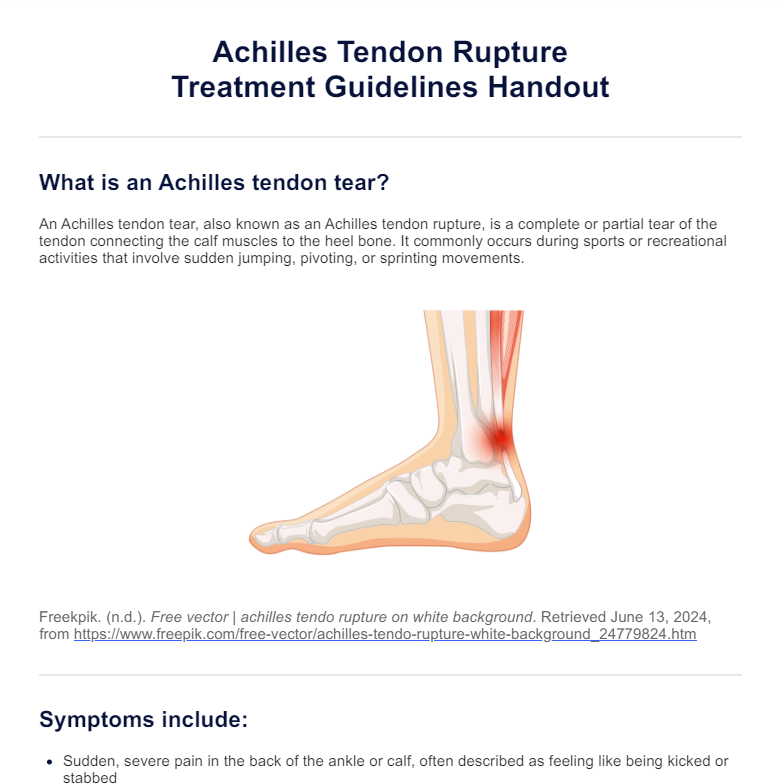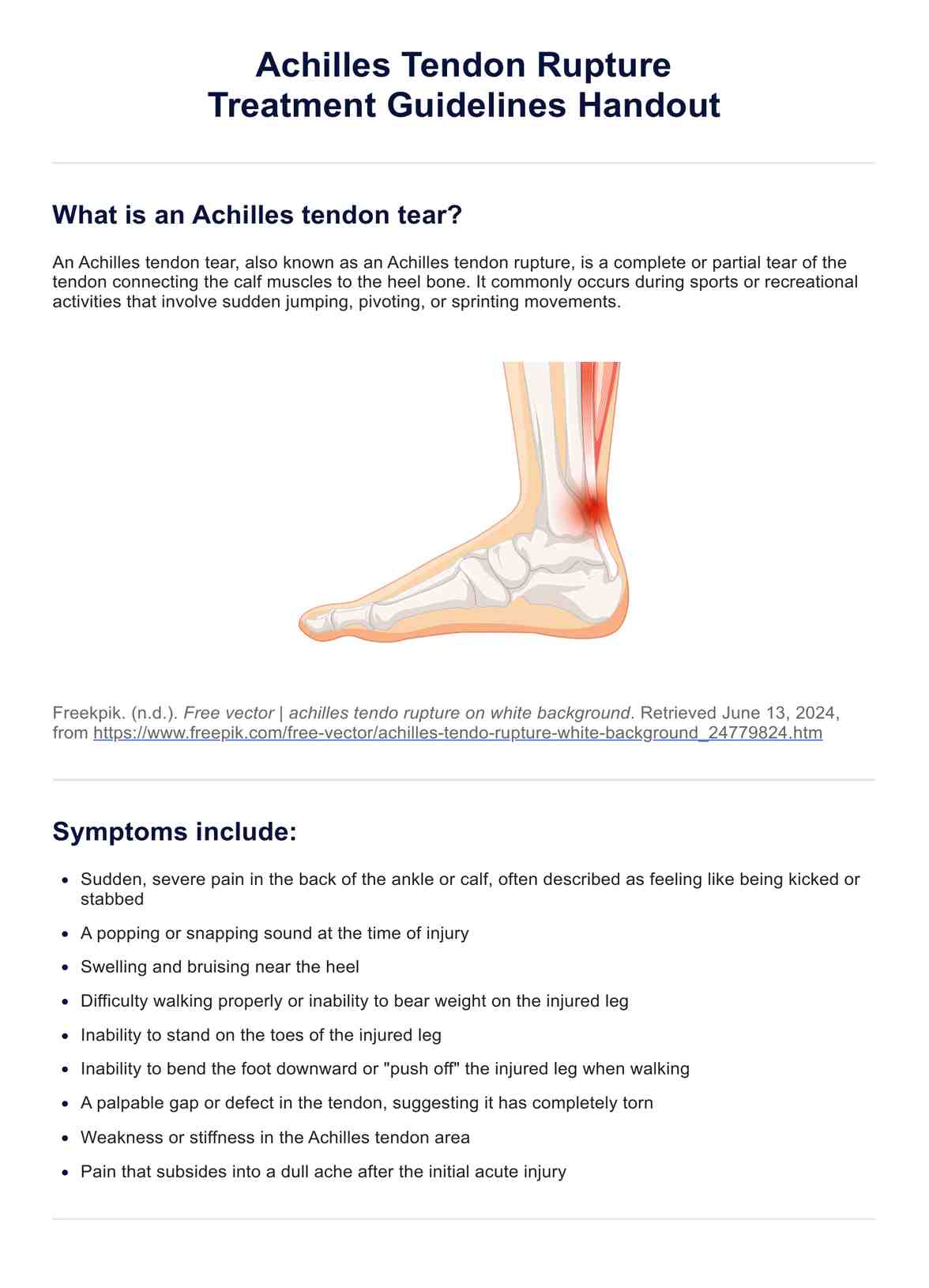Achilles Tendon Tear Treatment Guidelines Handout
Here is a free Achilles Tendon Tear Treatment Guidelines Handout to support your patients' treatment. Download today!


What is an Achilles tendon tear?
An Achilles tendon tear, also known as an Achilles tendon rupture, is a common injury that occurs when the tendon connecting the calf muscles to the heel bone is partially or completely torn. A completely ruptured Achilles tendon requires careful diagnosis to determine the extent of the injury and to discuss treatment options, including the choice between surgical and nonsurgical management. Symptoms may include a popping sound, severe pain, swelling, and difficulty walking or standing on the affected leg. Complications can include weakness, decreased range of motion, and an increased risk of re-injury if not properly treated.
Achilles Tendon Tear Treatment Guidelines Handout Template
Achilles Tendon Tear Treatment Guidelines Handout Example
How to manage and treat an Achilles tendon tear
With proper treatment and rehabilitation, most people can make a full recovery. Here are some ways to manage and treat Achilles tendon tear:
Rest and immobilization
Initially, rest the affected leg and avoid weight-bearing activities. You may recommend using crutches and wearing a cast or walking boot to immobilize the tendon and promote healing.
Physical therapy
Once the initial healing phase is complete, physical therapists will guide a rehabilitation program to restore strength, flexibility, and range of motion. This program may include exercises, stretches, and manual therapy techniques.
Surgery
In some cases, particularly complete tears or in active individuals, surgical repair may be necessary. The surgeon will stitch the torn tendon back together, allowing it to heal in its proper position.
Achilles tendon surgery carries certain risks, including the potential for skin breakdown and infection. The recovery time can be quite long, often requiring several months before normal activities can be resumed. Physical therapy is crucial during this period to promote tendon strength and improve ankle motion. This therapy helps in reducing stiffness and ensuring a more effective recovery.
Ice and elevation
Apply ice to the injured area for 15-20 minutes at a time, several times daily, to reduce pain and swelling. The leg should be elevated above the level of your heart as much as possible.
What is an Achilles Tendon Rupture Treatment Handout?
An Achilles Tendon Rupture Treatment Handout is a comprehensive guide for healthcare professionals, such as physical therapists, orthopedic surgeons, and sports medicine physicians, to use when treating patients with Achilles tendon tears.
The handout includes information on the symptoms, treatment options for this injury, and a rehabilitation protocol. This resource is useful when educating patients about their injury and the recovery process, ensuring they understand the importance of following the treatment plan for outcomes.
Using our treatment guidelines template
Download and print the PDF file
To begin using the Achilles Tendon Tear Treatment Guidelines Template, you must download the PDF file. It's a good idea to print several copies at once to have them readily available for upcoming patient visits.
Review the handout with your patient, highlighting key points
When your patient comes in for their visit, provide them with the customized handout and verbally review it. As you review the information, emphasize the most critical aspects relevant to their specific case. Encourage your patient to ask questions about the handout and provide clarification as needed to ensure they fully understand the information.
Document the handout provision in the patient's medical record
After reviewing the treatment guidelines handout with the patient, make a note in their medical record or chart indicating that you provided and discussed the handout with them. This documentation helps ensure continuity of care and communicates to other providers what education the patient has received.
Benefits of using this handout
Using our Achilles Tendon Tear Treatment Guidelines Handout offers several benefits for both healthcare professionals and patients:
Ensures consistent, evidence-based care across all patients
The handout provides a standardized treatment protocol for acute Achilles tendon ruptures, helping ensure that all patients receive the most up-to-date, evidence-based care. This is especially important for managing ruptured Achilles tendons, as treatment approaches among healthcare providers can vary.
Enhances patient education and understanding
The handout is for patients to learn more about their Achilles tendon injury, whether a partial tear or complete rupture. It clearly explains what an Achilles rupture is, how it affects the connection between the calf muscle and heel bone, and what to expect during the treatment and recovery.
Improves patient compliance with the Achilles tendon rehabilitation program
Adhering to the prescribed rehabilitation protocol is crucial for successful recovery after Achilles tendon repair surgery or conservative treatment of a ruptured Achilles tendon. The handout clearly outlines the rehabilitation process, including weight-bearing progression, range-of-motion exercises, and strengthening of the calf muscles.
Saves time for healthcare professionals by providing a ready-to-use, comprehensive resource.
Treating Achilles tendon injuries through conservative management or surgical repair requires extensive patient education and guidance. The Achilles tendon treatment guidelines handout consolidates all the necessary information into a comprehensive resource that healthcare providers can efficiently distribute to patients.
Commonly asked questions
Recovery time varies depending on the severity of the tear and the treatment approach. Most patients can expect to return to normal activities within 4-6 months, with full recovery taking up to a year.
Yes, many Achilles tendon tears can be treated non-surgically with a combination of rest, immobilization, and physical therapy. However, surgery may be recommended for complete tears or in active individuals who wish to return to high-demand activities.
To reduce your risk of Achilles tendon tears, gradually increase the intensity and duration of your workouts, wear proper footwear, and perform regular stretching and strengthening exercises for your calf muscles.







































































































